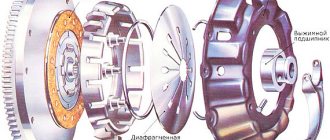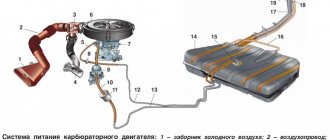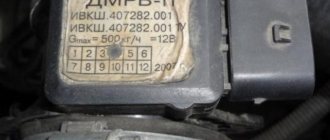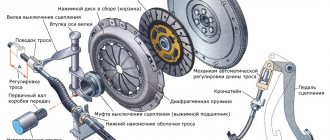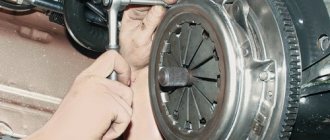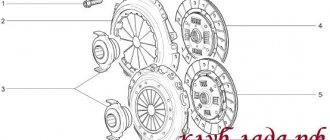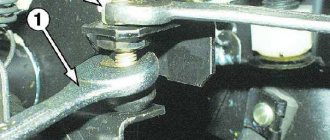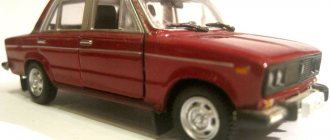Clutch kit
The clutch is necessary to disconnect the gearbox input shaft from the engine crankshaft. This operation is carried out using two disks - a master and a slave. The VAZ 2106 clutch is replaced when these elements are worn out.
The drive disk is located on the flywheel and is attached to it with bolts. The second name for this disc is the clutch basket. If you look closely, you can find some similarities between the part and a simple basket used by mushroom pickers. Only it contains not mushrooms, but a driven disk, which is rigidly connected to the input shaft of the box.
The connection to the drive disk is made through friction linings made of ferodo material. If the clutch of a VAZ is lost, worn-out linings are to blame.
Clutch device
The “six” is equipped with a dry clutch with 1 disc, operating in a permanent closed mode. It is equipped with a spring pressure element located in the center and a vibration damping device located on the driven clutch disc. The mechanical section of the unit is a non-separable part, which includes a protective housing, a push-action clutch disc and a diaphragm-type spring. The protection housing is attached to the flywheel with special mounting-type bolts and pins. This disc is mated to the safety housing with 3 pairs of steel plates that connect the clutch disc and the protective housing part.
With the help of locking fasteners, the VAZ 2106 clutch basket (also known as a pressure disk) is articulated with the outer segment of a diaphragm-type spring. The spring itself is directly held on 2 rings of the protective housing part with rivets. The 12-sector standard clutch disc with driven slots is made of steel. Friction linings are connected to the sector elements of the product separately from each other. To attenuate passive torsion pulses, the VAZ 2106 clutch mechanism contains a damper located between the hub and the driven disc.
The hydraulic part of the mechanism consists of the GCC and RCS (clutch master and slave cylinders), as well as a clutch fork, a release bearing, a fluid reservoir and a clutch foot pedal with a spring. The reliability of the clutch mechanism, the price of which is quite high, depends not only on the length traveled during the period of operation, but also on the conditions of its functioning and the degree of load. If the clutch fails in a VAZ 2106, this means that, most likely, you will need to adjust the size of the free movement of the foot drive.
Sometimes it happens that the clutch pedal fails due to a break in the cable of this mechanism. If the VAZ 2106 clutch slips, then an accelerated wear process occurs, the so-called. "ferrado", i.e. friction linings of the disc, clutch basket diaphragm and flywheel interacting with the engine. The lack of free movement of the foot drive also indicates wear of the clutch basket. The dismantling and repair of this important unit can be seen in the film “VAZ 2106 clutch”, video instructions for which are presented in the next viewing frames on our Internet portal.
The clutch pedal has fallen in and won't return, what's the problem?
When the clutch pedal fails and does not return, it means only one thing - the clutch is out.
It is necessary to go to the site or replace the clutch parts yourself. The difference may be that only the retaining plate may be damaged, but the disc and basket will last for some time. It may also happen that the disc and basket are so worn that it is better to buy and replace the entire clutch. If the clutch fails, there is no need to panic, this is everyday life and was bound to happen sooner or later. However, when the clutch pedal fails, it may not always mean that the clutch needs to be replaced. Sometimes there are cases when the brake fluid has simply leaked and it is necessary to top it up and see where it is leaking and eliminate the gap. However, there are other reasons why the clutch pedal does not return to its original position.
Common reasons why the clutch pedal does not return
If you have the tools and experience in auto repair, much of the clutch repair work can be done in the garage yourself. If you don’t have that kind of experience and don’t have the desire to dig into your car, it’s better to immediately call a mechanic or come to a gas station.
What can happen to the clutch if the pedal does not release:
- brake fluid has leaked from the system - this is the best that can happen - just fill up the brake fluid and go to the service center;
- The clutch cable is broken, nothing can be done on the spot, buy a new cable and put it in place;
- air has entered the system, this problem can be eliminated by bleeding the clutch pedal, which clears the system of air;
- the return spring has flown off or broken, the way out of the situation is to restore the spring yourself; if it breaks, you need to tow the car to a service center; it will be difficult to do this yourself;
- to failure of the clutch pedal, maybe also because the fork has broken the clutch engagement, in this situation there is also nothing to do, you need to drag the car to a service station;
- the clutch master cylinder has fallen off, you can try to sharply press the clutch pedal, and try to engage the gear and go to the service station to replace this cylinder, and it is also advisable to change everything else: the bearing, disk and carriage.
There are also cases when the clutch pedal gets stuck and cannot be removed. This means that urgent clutch repair is required. But how to get to the gas station? It's very simple, there are several ways. We won’t talk about trivial ones, such as calling a tow truck or asking someone to pull someone to a place.
Instructions on how to get to the service center if the clutch pedal fails
Driving alone with a failed clutch requires a little ingenuity. You won't be able to go fast, but you'll get there easily in 2nd gear. The main thing is that the battery and starter are in good condition. You should also understand that you can only change gears painlessly with the engine turned off.
It turns out that if the car is parked, you need to engage reverse gear. Then start the engine by pressing the gas pedal and the car will start moving in reverse. When the car moves back the required distance, you can turn off the engine and engage first or second gear. Once the engine starts, apply throttle and the car will immediately move away, shaking slightly for the first few seconds.
This way you can shift to second gear without haste. You can also try pulling out second gear and shifting into fourth, so you have to push the clutch as much as possible. If it is not possible to change gears more or less easily, it is better not to damage the gearbox and not to rush while driving in second gear.
Several features of driving with a damaged clutch:
- It is better to leave the car on a descent or a flat road, in no case on a slope, because on a slope it will be more difficult to start with a broken clutch pedal;
- you need to rethink the route to the gas station so that there are fewer traffic lights and forced stops, it is best to switch to second gear once and drive without stopping;
- before you go on a trip, warm up the engine, put the gear shift lever in neutral, if the engine is well warmed up, you can even try starting it in third gear;
- It would be a good idea to turn on the hazard warning lights while driving so that other road users understand that the car is out of order and has not given a signal;
- Without stopping often, you can slow down and calculate the situation in advance, but if the traffic situation forces you to stop, stop and pull over, turn off the engine and then restart it;
- For those with little driving experience or fear, the easiest thing to do is find a rope and have someone tow it, or for those with extra money, call a tow truck;
To avoid such unpleasant situations, you need to periodically, every 5-7 thousand. km when changing the oil, carry out diagnostics. Then the ride will only be fun.
Clutch faults
There is a list of VAZ 2106 clutch malfunctions, which are presented in the table in this article. If the clutch is lost, you should look for a defect in the unit here:
Clutch faults | How to fix |
| The clutch "drives" | |
| 1. Large gap in the hydraulic drive | 1. Make adjustments |
| 2. Deformation of the driven disk | 2. Repair or replace |
| 3. The surfaces of the friction linings of the driven disk have defects | 3. Remove with a metal brush |
| 4. Weak rivets or defective linings | 4. Replace |
| 5. Incorrect operation of the clutch disc hub on the splined part of the manual transmission shaft | 5. Clean and lubricate; if worn, replace |
| 6. Defects in the connecting plates between the flange and the clutch body protection | 6. Replace the necessary parts |
| 7. Air locks in hydraulics | 7. Bleed the clutch |
| 8. Hydraulic fluid leaks through joints or defects in hydraulic pipes | 8. Tighten fasteners, replace defective spare parts, bleed the hydraulic system after it is tight |
| 9. Fluid leakage from the main circulation system or dispenser | 9. Change the O-rings, bleed the hydraulic system after it is tight |
| 10. The hole in the cover of the clutch reservoir was clogged, which created the effect of a vacuum in the pressure in the hydraulic fluid mass and the suction of air masses into the cylinder through the sealing gaskets | 10. Blow out the air channel in the cover with a compressor, bleed the hydraulic system after it is sealed |
| 11. Lack of tightness due to a worn gasket ring. | 11. Clean the seal; if defective, replace it |
| 12. Weak rivets of the pressure spring fasteners | 12. Replace the clutch housing and basket |
| If the VAZ 2106 clutch slips | |
| 1. There are no gaps in the hydraulic drive | 1. Make adjustments |
| 2. Increased wear or burning of the ferrado | 2. Replace the ferrado or the entire slave disk |
| 3. The friction linings are dirty with oil, as are the working parts of the flywheel and clutch basket. | 3. Wash and degrease working and mating surfaces, eliminate oil leaks |
| 4. The GCS compensator hole is clogged | 4. Rinse and clean the hole-compensator of the main fluid circulation system |
| VAZ 2106 clutch “tears” | |
| 1. The hub of the driven disc “sticks” on the splines | 1. Wash and clean the splines; if the shaft or disk splines are worn, replace the product |
| 2. Ferrado linings in engine or transmission oil, as well as the working surfaces of the flywheel and clutch basket | 2. Wash and degrease working and mating surfaces, eliminate oil leaks |
| 3. Increased wear of friction disc linings | 3. Replace with updated products, and also test for defects in the disk mating areas |
| 4. Weak rivets on the Ferrado | 4. Change defective rivets, and, if necessary, linings |
| Increased noise when disengaging the clutch mechanism | |
| 1. Oil leak and release bearing defects | 1. Exchange the product for a new one |
| 2. Oil leakage and defects in the manual transmission shaft bearing | 2. Exchange the product for a new one |
| Increased noise when engaging the clutch mechanism | |
| 1. Defects in the springs of the damper device | 1. Exchange the product for a new one |
| 2. Defects in the mechanism fork return spring | 2. Replace the product with a new one or strengthen the fasteners |
| 3. Defects in the plate connections of the protective housing with the disk | 3. Exchange the product for a new one |
The table shows the most common clutch malfunctions in practice.
The clutch pedal falls all the way when pumping on a VAZ
- How to nap the chipping cylinder on a VAZ 2101? – 5 answers
- The clutch doesn't work well! – 4 answers
- It is difficult to change gears on a VAZ 2101 - 3 answers
- I can’t bleed the VAZ clutch – 3 answers
- Clutch disappears - 2 answers
How to bleed the clutch is described below or provided in this article; if the clutch does not bleed or does not engage, then the problem may be in the clutch master cylinder (MCC), in the clutch slave cylinder.
If anything, then repair - replacement of hoses, replacement of cuffs
The pedal falls, but the clutch does not release, then this means there is air in the hydraulic system. Or the cuffs in the clutch master cylinder have worn out and are leaking brake fluid.
Previously, when there was a shortage of spare parts. parts, bought cuffs, removed and sorted out the main clutch and clutch slave cylinder. But this did not always help, because the cylinder mirror also wears out, and the seal could not be obtained even with new cuffs. Time was wasted on rearranging the cuffs in vain and we had to look in stores for a new clutch master cylinder or clutch slave cylinder.
With the clutch slave cylinder it is easier, or rather faster, it was clear if it does not work, the cuffs are leaking, then it is wet, the fluid decreases in the reservoir. If you still go through it and install new cuffs, then after filling the brake fluid you will also see whether the new cuffs are holding or not (meaning, if they don’t hold, then there will be leaks from the cylinder, it will get wet again and not work).
But with the master cylinder it may be different. Let’s say the working cylinder is working properly, that means there is “trouble” in the main circulation system. If the cuff that is closer to the passenger compartment is worn out and the brake fluid leaves the reservoir, then dampness will appear in the passenger compartment, where the rod enters the clutch from the pedal, through the engine shield. If the interior is dry, in the sense that fluid does not come out near the rod, and there is no decrease in the reservoir, and there is no pedal pressure, the clutch does not disengage, then the second cuff is worn out, it bypasses the brake fluid, the fluid is driven through the cylinder itself and is not pressed into the system. You can, of course, buy cuffs and sort out the main fluid circulation system, it may help, but maybe not if there is a large hole in the walls of the cylinder (sometimes an oval hole is packed). Now they make it simpler, buy a new cylinder and install it.
A small hint (but important): in order not to have to suffer for a long time with pumping the clutch, before installing the clutch, you need to pump it by hand, that is, pour the brake fluid into the reservoir and pump the piston several times with the piston pusher. As soon as the liquid flows out of the outlet, plug it and install the GCS in place. Then, when the cylinder is in place, remove the plug and connect the tube. A little brake fluid will leak out, but it’s not a big deal, you’ll need to add more to the reservoir, the main thing is that it doesn’t completely leak out of the reservoir, because if additional air gets through the reservoir, then again you’ll have to pump the air for a long time and persistently with the pedal.
And if the clutch is pumped and there is already brake fluid in it, then after installing it in place, the clutch starts working almost immediately; there is little need to pump. This is if the worker is in good working order and there is liquid in it.
If you only checked the working cylinder, then you don’t have to push it with the pedal for a long time either, just open the bleeder fitting and wait a few minutes. Monitor the brake fluid level in the master cylinder reservoir and top it up on time.
Well, actually, if you don’t miss the start of fluid flowing out of the working cylinder, then a little of it will flow out. Close the fitting. Test the clutch pedal. If everything is done carefully, then sometimes there is no need to bleed, the clutch works immediately, there is a release. Even if the squeeze is not full, in the sense that there is some air in the system, then bleeding does not take much time, it will quickly pump and the pedal will work as it should and the clutch will disengage.
Yes, if you installed a new clutch, then adjustment is needed on the clutch slave cylinder rod.
Preparing to adjust the clutch
Some car owners are wondering how a VAZ 2106 can cost less and be better without hiring expensive professionals. Therefore, our article outlines how to carry out the entire complex of technological operations for adjusting the clutch of a VAZ “classic” with your own hands in a garage or inspection pit.
It should be understood that if deficiencies appear in this mechanical assembly, then adjustment of the clutch is required to allow correct functioning. Adjustment, a video about which is located on the Internet, is needed when pressing the foot pedal for turning on this mechanism unit reveals shortcomings in the operation of the unit. Such malfunctions include:
- dips when pressed;
- there is no complete integration of the mechanism in the working joint with the box with loss of elasticity;
- other possible shortcomings.
Let's sum it up
As you can see, problems associated with the clutch on a manual transmission in some cases can completely immobilize the car. If the problem is related to the clutch pedal, that is, the driver loses the ability to control the operation of the clutch, then repair is also necessary, however, if you have certain skills and abilities, you can drive to a service station or other place where the car is repaired under your own power.
If necessary, it is also recommended to adjust the clutch pedal, bleed the clutch, and also take into account even the slightest malfunction of this unit during vehicle operation.
Types of clutch drive. If the clutch pedal falls, the clutch has become soft, problems have arisen with the clutch: causes and repair of major faults.
How to adjust the clutch pedal, what adjustment is needed for: clutch functions, clutch pedal adjustment (free play and total travel).
Manual transmission gears (speeds) do not engage after replacing the clutch: main reasons, settings and adjustments. Diagnosis of problems, useful tips.
Clutch disc: purpose and device. How to replace a clutch disc, replace this element yourself. Recommendations.
Pro Tips
Experienced auto mechanics recommend following the advice.
- When pumping, only high-quality fluid should be used.
- Operations related to the clutch must only be carried out cleanly. Dirt entry is unacceptable.
- It is recommended to check the clutch settings every 3-4 months of active use. The maximum permissible deviation from the working position is 10% of the range width.
Specialization : Graduated from the State Automobile University, worked for 20 years at GAZ-56, now I drive a Zhiguli.
Source
Work on top of the car
So, a start has been made, the goal is to remove the gearbox to replace the clutch. On VAZ 2106 and similar cars this is done quite quickly, it is only important to follow a certain sequence:
- Inside the car, remove the gear shift knob. It is attached using plastic latches. Sometimes difficulties arise with dismantling, and it gets to the point where the latches break off. The price of a new set of fastenings is no more than one hundred rubles, and you can purchase it even after repairs have been carried out. Therefore, do not be afraid if you suddenly break the plastic antennae.
- Go to the engine compartment, unscrew the four nuts that secure the exhaust pipe to the manifold. The fact is that the exhaust pipe will interfere with the removal of the box, but it is enough to move it a little to the side.
- Disconnect the battery and remove it from the car.
- Unscrew the two top bolts of the starter, disconnect the power wires for the windings and the solenoid relay from it.
- Disconnect the ground wire that goes to the gearbox.
Carefully inspect whether there are any “upgrades” on your vehicle specifically that will interfere with the removal of the transmission. If there are any, then make sure that they do not complicate further repairs.
